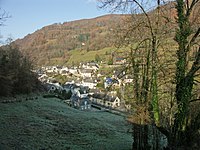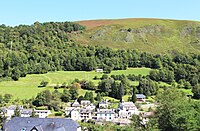Juncalas
|
Juncalas Juncalàs |
||
|---|---|---|

|
|
|
| region | Occitania | |
| Department | Hautes-Pyrénées | |
| Arrondissement | Argelès-Gazost | |
| Canton | Lourdes-2 | |
| Community association | Tarbes-Lourdes-Pyrénées | |
| Coordinates | 43 ° 3 ′ N , 0 ° 0 ′ E | |
| height | 451-876 m | |
| surface | 3.51 km 2 | |
| Residents | 166 (January 1, 2017) | |
| Population density | 47 inhabitants / km 2 | |
| Post Code | 65100 | |
| INSEE code | 65237 | |
 Mairie Juncalas |
||
Juncalas ( Occitan : Juncalàs ) is a French commune with 166 inhabitants (as of January 1, 2017) in the Hautes-Pyrénées department in the Occitanie region (until 2015 Midi-Pyrénées ). The municipality belongs to the Arrondissement of Bagnères-de-Bigorre and the Tarbes-Lourdes-Pyrénées municipal association, founded in 2016 . The inhabitants are called Juncalésiens .
geography
The municipality of Juncalas is located in Lavedan within the Bigorre landscape in the foothills of the Pyrenees , about 30 kilometers south of the city of Tarbes and eight kilometers southeast of the pilgrimage site of Lourdes . The 3.51 km² municipal area of Juncalas includes part of the high valleys of Louey and Nès , which flow down to the Gave de Pau, as well as the slopes and mountain peaks flanking the Louey valley to the north. While the village of Juncalas is 460 m above sea level, the mountains tower over the high valley by over 400 meters. The highest peaks in the Juncalas municipality are called Tucoulet ( 876 m ) and Herrus ( 818 m ). About half of the community area is forested. The hamlet of Les Moulins de Juncalas belongs to the municipality of Juncalas .
Juncalas is surrounded by the neighboring municipalities of Sère-Lanso in the north, Cheust in the east, Ourdis-Cotdoussan and Gazost in the southeast, Ourdon in the south, Ousté in the west and Saint-Créac and Artigues (point of contact) in the northwest.
Place name
In 1285 the toponym Iuncalas appeared for the first time . This was followed by the spellings Junqualacz (1313), the Latin de Junqualassio (1319), de Juncalassio (1342) as well as Iumqualas and Iuncalas (1384), before finally the name Juncalas, which is still valid today, with the appearance of the Cassini cards at the end of the 18th century asserted. The name probably goes back to the Occitan word jonc / Latin juncus (= rushes ).
Population development
| year | 1962 | 1968 | 1975 | 1982 | 1990 | 1999 | 2007 | 2017 | |
| Residents | 236 | 214 | 164 | 148 | 170 | 193 | 183 | 166 | |
| Sources: Cassini and INSEE | |||||||||
Attractions
- Notre-Dame-de-l'Assomption (Assumption) Church
- Saint-Roch Chapel (St. Rochus)
- two wash houses ( lavoirs )
Economy and Infrastructure
Agriculture dominates in Juncalas. There are eight livestock farms in the municipality (cattle, sheep and goats).
Juncalas is a somewhat remote mountain community. The city of Lourdes , eight kilometers away, is a local transport hub on the northern edge of the Pyrenees.
supporting documents
- ^ "Dictionnaire toponymique des communes des Hautes-Pyrénées, Tarbes, Conseil Général des Hautes-Pyrénées, 2000" ( Toponymic Dictionary of the Communes of the Hautes-Pyrénées ) by Michel Grosclaude and Jean-Francois Le Nail ( ISBN 2-9514810-1-2 )
- ↑ Juncalas on cassini.ehess.fr
- ↑ Juncalas on insee.fr
- ↑ Farms on annuaire-mairie.fr (French)







